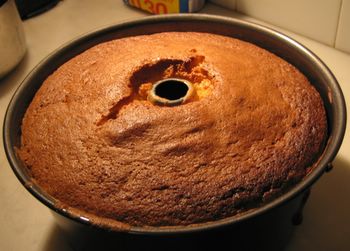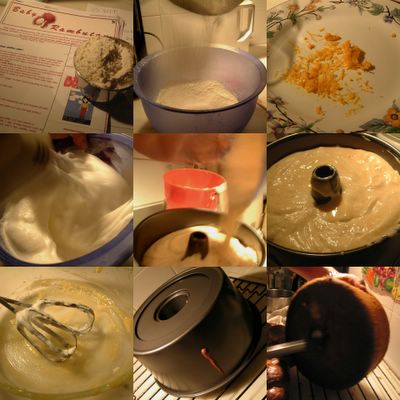Orange Glow Chiffon Cake
I had a postal notice last Thursday to claim a package. I was not sure where it was from but I somehow had this idea its probably the TUBE PAN for angel cake from my friend Stephanie. She is my half English and Greek friend way back during the senior years at school and now lives at Milwaukee, USA. On Wednesday night we chatted and she said I should get my pan next week. It came few days earlier than expected , a perfect birthday present.

After all the months of waiting when I first saw the orange chiffon cake recipe at Baby Rambutans
I finally baked the cake with the help of M. Stel's recipe is from The Cake Bible by Rose Levy Beranbaum and she used Grand Marnier.
The only difference of ours is we used Cointreau and we did not have cream of tartar. But the egg whites formed lovely peaks. As soon the egg whites were all beaten the egg white mixture was immediately folded into the flour egg batter.
With M's advice the egg white was divided into half and was carefully cut into the mixture and fold over while working as little as possible.
This prevents the mixture from getting elastic.
Then continued with the other half folding as gently as possible so as not to break down the egg whites.
As soon it came out from the oven I turned it over a wire rack and went out for a walk so I wont be tempted to slice it before it cooled down completely.

Going thru Stel's notes, sifting the flour, grated orange zest,whipping the egg whites, transferring the mixture to tube pan, ready for baking, whisk, turning cake upside down and unmoulding the chiffon.
And here some information about Chiffon cake which I found from
THE JOY OF BAKING
The Chiffon Cake is a cross between a butter and a sponge cake. Similar to a butter cake in that it contains baking powder and does have fat, albeit it is in liquid form
The chiffon is similar to a sponge cake in texture and that the eggs are separated. The whites are stiffly beaten and then folded into the batter which contributes to the cake's leavening. The batter is baked in an ungreased tube pan which allows the batter to cling to the sides of the pan as it rises. The tube in the center of the pan enables the hot air to circulate so the heat can reach the center of the cake. Once baked the cake is inverted until cool to keep the cake from shrinking and losing its volume.

Glowing cake indeed!!
Thank you Stel and Stephanie at least I will never forget the year I turned 36 years old I baked my first chiffon cake.
Recommended reading:
FRENCH PROFESSIONAL PASTRY SERIES (Doughs, Batter and Meringue) by Roland Bilheaux and Allain Escoffier.

After all the months of waiting when I first saw the orange chiffon cake recipe at Baby Rambutans
I finally baked the cake with the help of M. Stel's recipe is from The Cake Bible by Rose Levy Beranbaum and she used Grand Marnier.
The only difference of ours is we used Cointreau and we did not have cream of tartar. But the egg whites formed lovely peaks. As soon the egg whites were all beaten the egg white mixture was immediately folded into the flour egg batter.
With M's advice the egg white was divided into half and was carefully cut into the mixture and fold over while working as little as possible.
This prevents the mixture from getting elastic.
Then continued with the other half folding as gently as possible so as not to break down the egg whites.
As soon it came out from the oven I turned it over a wire rack and went out for a walk so I wont be tempted to slice it before it cooled down completely.

Going thru Stel's notes, sifting the flour, grated orange zest,whipping the egg whites, transferring the mixture to tube pan, ready for baking, whisk, turning cake upside down and unmoulding the chiffon.
And here some information about Chiffon cake which I found from
THE JOY OF BAKING
The Chiffon Cake is a cross between a butter and a sponge cake. Similar to a butter cake in that it contains baking powder and does have fat, albeit it is in liquid form
The chiffon is similar to a sponge cake in texture and that the eggs are separated. The whites are stiffly beaten and then folded into the batter which contributes to the cake's leavening. The batter is baked in an ungreased tube pan which allows the batter to cling to the sides of the pan as it rises. The tube in the center of the pan enables the hot air to circulate so the heat can reach the center of the cake. Once baked the cake is inverted until cool to keep the cake from shrinking and losing its volume.

Glowing cake indeed!!
Thank you Stel and Stephanie at least I will never forget the year I turned 36 years old I baked my first chiffon cake.
Recommended reading:
FRENCH PROFESSIONAL PASTRY SERIES (Doughs, Batter and Meringue) by Roland Bilheaux and Allain Escoffier.

0 Comments:
Post a Comment
<< Home